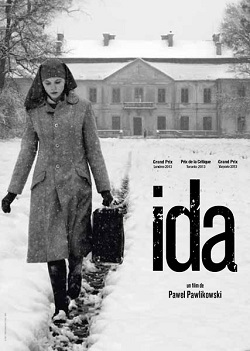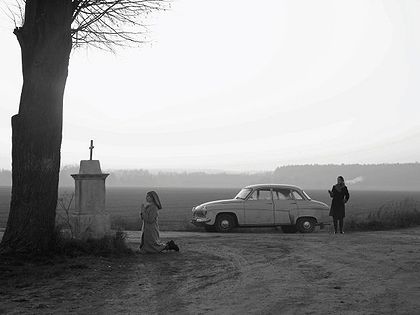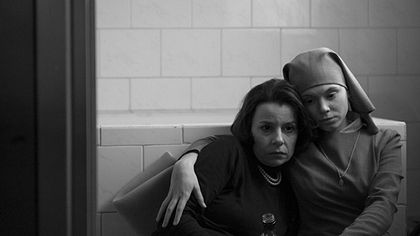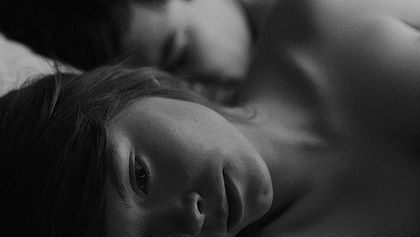The film which won the Oscar for Best Foreign Language Film, “Ida”, is a battle between reason and faith, the body and the spirit, hatred and forgiveness.
 Ida reminds us that Jesus came to forgive sinners.
Ida reminds us that Jesus came to forgive sinners.
If understanding someone means putting yourself in their shoes, fiction tries to accomplish the things we are unable to do in reality by experimenting with the life of another person.
“We live in the apotheosis of narcissism become ideology – says Pawlikowski –. We are what matters most”. The film’s main character, Ida, “does not think that she is the centre of the universe”. Her dazzling gaze expresses the shock of a lifetime, compressed into barely six months in the life of a young novice living in Poland in the 1960s.
For a few days, Anna leaves the convent that she has grown up in and in which she is about to take her vows to meet her aunt Wanda, her only family. Together they go on a journey in search of their origins, having to face up to the guilt of a forgotten past. The country is under a communist regime, while it is as if Anna has been living in the Dark Ages. Her aunt has gone through all the horrors of the twentieth century, first the Holocaust and then the Stalinist repression.
 Ida introduces us to a novice who leaves a convent in Poland in the 60’s.
Ida introduces us to a novice who leaves a convent in Poland in the 60’s.Nothing is as it appears. Anna’s real name is Ida and she is Jewish. Her parents were murdered during the Second World War, in unclear circumstances. When we meet her aunt Wanda, we see a man getting dressed as he leaves her room. We wonder whether she has gone into prostitution but then discover that she is a judge. It isn’t long before we discover that she played an important role in the Stalinist terror. They called her Red Wanda.
Pawlikowski was born in 1957, when Poland had a bureaucratic and corrupt system, based on a structure of totalitarian power, lacking any ideology. The 1960s saw some relaxation but at fourteen Pawlikowski went to Italy and Germany, finally settling down in England, where he started making documentaries in the 1980s. “Ida” is his fifth film, but in it he also goes back to the country of his childhood, without the music, colour and camera movements which had, up to now, defined his films.
DAZZLING GAZE
Nowadays, what we have seen on screen does not stay with us for long after the credits. This moving story, however, filmed in striking black and white, has a hypnotic effect. It took me back to the years when I first started to love films.
 An aunt and her nephew start a trip in which they reflect on how faith confronts evil.
An aunt and her nephew start a trip in which they reflect on how faith confronts evil.If you didn’t know anything about this film, you would think that it had been filmed in the period in which it is set. It isn’t contemporary. The format is almost square, like something out of the televisions of the 1960s. It doesn’t have the nervous movements of hand-held cameras. Nothing appears fake or projected.
As Carlos Boyero puts it, “the convent cloisters under the snow, fog drifting towards a wood, a feeble ray of sunlight filtering into a cemetery, all look like they have always belonged to those landscapes, that they have not been staged”. The only music is the music played at home (Bach and Mozart), the chants in the convent, or the jazz group playing Coltrane’s “Naima” in a hotel.
In the eighty minutes that the film lasts there is nothing superfluous, nothing missing. In the space created by the fixed-camera shots, the characters only take up a small part of the screen. Paul Schrader observes that the surprising final scene could be reminiscent of “The Third Man”, but the shot is so unusual that even someone with his experience of films, says that he has never seen anything quite like it.
It is not surprising that wherever this film goes, it is met with awards. It picked up the International Critics Award at the Toronto Film Festival, along with the top awards in its own country. It won six prizes at the Gijón International Film Festival, including best film, script and actress. Although it came out last year, it is still in cinemas around the world.
MAGNETIC ATMOSPHERE
Anna follows the daily routine of devotion and service at the convent, while Wanda is a woman traumatized by the Holocaust, alcoholic and promiscuous. “Ida’s identity is defined by her faith and is not superficial”, says Pawlikowski. He explains that her faith evolves throughout the film, but never leaves her. Wanda is an intelligent woman, who really believed in Marxism. She felt more Communist than Jewish, but her idealism is replaced by disillusionment.
 The film shows her relationship with a young jazz saxophonist in a subtle way.
The film shows her relationship with a young jazz saxophonist in a subtle way.When Wanda tells Anna about her Jewish origins, she does it as some kind of settling of accounts. Aunt and niece set off on their journey with different agendas. Wanda sees it as a form of self-inflicted punishment, knowing what awaits her, but Anna lives with no interest in her past, oblivious of all the Idas that died in the extermination camps. The Jews in Poland were as much the victims of the Nazis as of Polish anti-Semitism. The people live as if they had vanished, perhaps adopting another identity.
At the end of their quest, neither of the women will be the same again. The film raises the themes of guilt and forgetting, which mingles with forgiveness. On their journey, they meet a young saxophonist who invites them to a jazz concert that he is playing in. His relationship with Anna is emblematic of the complexity and subtlety of this film. This is a story which is built around small gestures, pregnant silences and meaningful looks. The dialogues are brief and accurate, creating a “magnetic atmosphere”, according to Boyero.
SPIRITUALLY OVERWHELMING
“Ida” could be grossly summarized as the clash between an innocent novice and the evil of the outside world, but it is a much deeper and more complex story. There is a certain duality in Anna, showing us the light and dark side of one reality. Anna is Ida, and Ida is Anna. They are the same person, but they represent two paths that one same person could have taken. A possible reading of the conclusion is that Anna has to try to be Ida in order to be able to decide on her future.
 Ida reminds us that without identification there can be no compassion.
Ida reminds us that without identification there can be no compassion. Alissa Wilkinson takes another stance in her thought-provoking commentary in Christianity Today. Anna tries to understand why her Aunt did not want to look after her when she was orphaned, even after her sisters had asked her to do so. In order to understand the life that her aunt has chosen, she has to become her double in order to live in her reality. That is why she wears her clothes and follows what she does, to know what it is like to be her, to understand why she did what she did.
The space left around the faces of the characters suggests an invisible presence, the weight of an authority that cannot be seen. The film’s ascetic style is reminiscent of the nakedness in Bresson’s films, and of his Jansenist view that where sin increases, grace increases all the more. Before starting on their journey, Wanda asks Anna: “What if you go there and discover that there is no God?”. “Ida” is a battle between reason and faith, the body and the spirit, hatred and forgiveness.
THE MYSTERY OF INCARNATION
In a way, Ida makes us think of the Incarnation. We often talk about Judeo-Christian thought systems. The Greeks despised the body and material life, but is there anything less Jewish than the idea that God can live in a human body? Strictly speaking, Christianity is neither Greek nor Jewish. It presents us with the folly of the Creator becoming human, so that we can know and trust Him, and to offer us salvation through the greatest act of love that one person can offer another.
 The film show a conflict between flesh and spirit.
The film show a conflict between flesh and spirit.One night when Wanda is trying to drown her sorrows, she says to Anna: “Your Jesus didn’t hide in a cave with books, but went out into the world”. Christianity is not to be lived in a convent. “The Word became flesh and made his dwelling among us” says John (1:14). If “grace and truth came through Jesus Christ” (v.17), it was by experiencing our pain, to show us the real love that sets us free.
“Ida” is not only a story about finding our identity. It is a reflection on faith and its place “in the world”. Jesus prays to his father “My prayer is not that you take them out of the world but that you protect them from the evil one” (John 17:15). Wanda tells Ana that Christ came to forgive sinners like her. That is the Gospel! And that is what religion then, as now, can’t get its head around.

Las opiniones vertidas por nuestros colaboradores se realizan a nivel personal, pudiendo coincidir o no con la postura de la dirección de Protestante Digital.
Si quieres comentar o